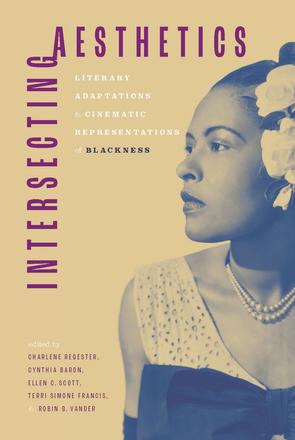
Intersecting Aesthetics
Literary Adaptations and Cinematic Representations of Blackness
How twentieth-century Black writers and filmmakers struggled to create authentic adaptations that reflected Black experiences
Description
Contributions by Cynthia Baron, Elizabeth Binggeli, Kimberly Nichele Brown, Priscilla Layne, Eric Pierson, Charlene Regester, Ellen C. Scott, Tanya L. Shields, and Judith E. Smith
Intersecting Aesthetics: Literary Adaptations and Cinematic Representations of Blackness illuminates cultural and material trends that shaped Black film adaptations during the twentieth century. Contributors to this collection reveal how Black literary and filmic texts are sites of negotiation between dominant and resistant perspectives. Their work ultimately explores the effects racial perspectives have on film adaptations and how race-inflected cultural norms have influenced studio and independent film depictions. Several chapters analyze how self-censorship and industry censorship affect Black writing and the adaptations of Black stories in early to mid-twentieth-century America. Using archival material, contributors demonstrate the ways commercial obstacles have led Black writers and white-dominated studios to mask Black experiences. Other chapters document instances in which Black writers and directors navigate cultural norms and material realities to realize their visions in literary works, independent films, and studio productions. Through uncovering patterns in Black film adaptations, Intersecting Aesthetics reveals themes, aesthetic strategies, and cultural dynamics that rightfully belong to accounts of film adaptation.
The volume considers travelogue and autobiography sources along with the fiction of Black authors H. G. de Lisser, Richard Wright, Ann Petry, Frank Yerby, and Walter Mosley. Contributors examine independent films The Love Wanga (1936) and The Devil’s Daughter (1939); Melvin Van Peebles's first feature, The Story of a Three Day Pass (1967); and the Senegalese film Karmen Geï (2001). They also explore studio-era films In This Our Life (1942), The Foxes of Harrow (1947), Lydia Bailey (1952), The Golden Hawk (1952), and The Saracen Blade (1954) and post-studio films The Learning Tree (1969), Shaft (1971), Lady Sings the Blues (1972), and Devil in a Blue Dress (1995).
Reviews
"Intersecting Aesthetics is a pivotal work from leading scholars in African American film studies. The influence of this collection will reach long into the future."
- Gerald R. Butters Jr., coeditor of Beyond Blaxploitation
"A riveting take on overlooked chapters in Hollywood history"
- Publishers Weekly
"Intersecting Aesthetics poises itself as an innovative and comprehensive work that offers significant contributions to the field of Black literary and film adaptations. Its methodological and analytic ingenuity enables new insights and helps critics challenge existing academic paradigms restrained by white norms in contemporary adaptation studies. This anthology demonstrates that racialized social discourses serve as a central factor that affects the creation, distribution, and reception of Black literature and cinematic adaptations. By combining incisive insights from various disciplines such as film and media studies, comparative literature, and African American studies, this volume enriches the scholarship on film adaptation, Black artistry, and African American experiences. The authors present literature and films as reflective, negotiating, and challenging racialized social hierarchies and cultural orders demised by whiteness."
- Xinyu Chen, Journal of Popular Culture
"There is a danger at times that adaptation studies can be overly celebratory, attempting—understandably so—to distance its methods from literary evaluation and the spectre of fidelity criticism. Yet what this volume repeatedly shows, without rehearsing debates around fidelity, are the ideological (and ultimately financial) investments that Hollywood, especially, has had in its projection of what a white audience seeks from representations of Blackness. This important book, one hopes, will be the first of many studies of Blackness and adaptation, with much left to say about adaptations beyond the twentieth century (many rich examples of which are acknowledged in a footnote in the introduction) and exploring further the phenomenon beyond US borders."
- Gillian Roberts, University of Nottingham, Adaptation